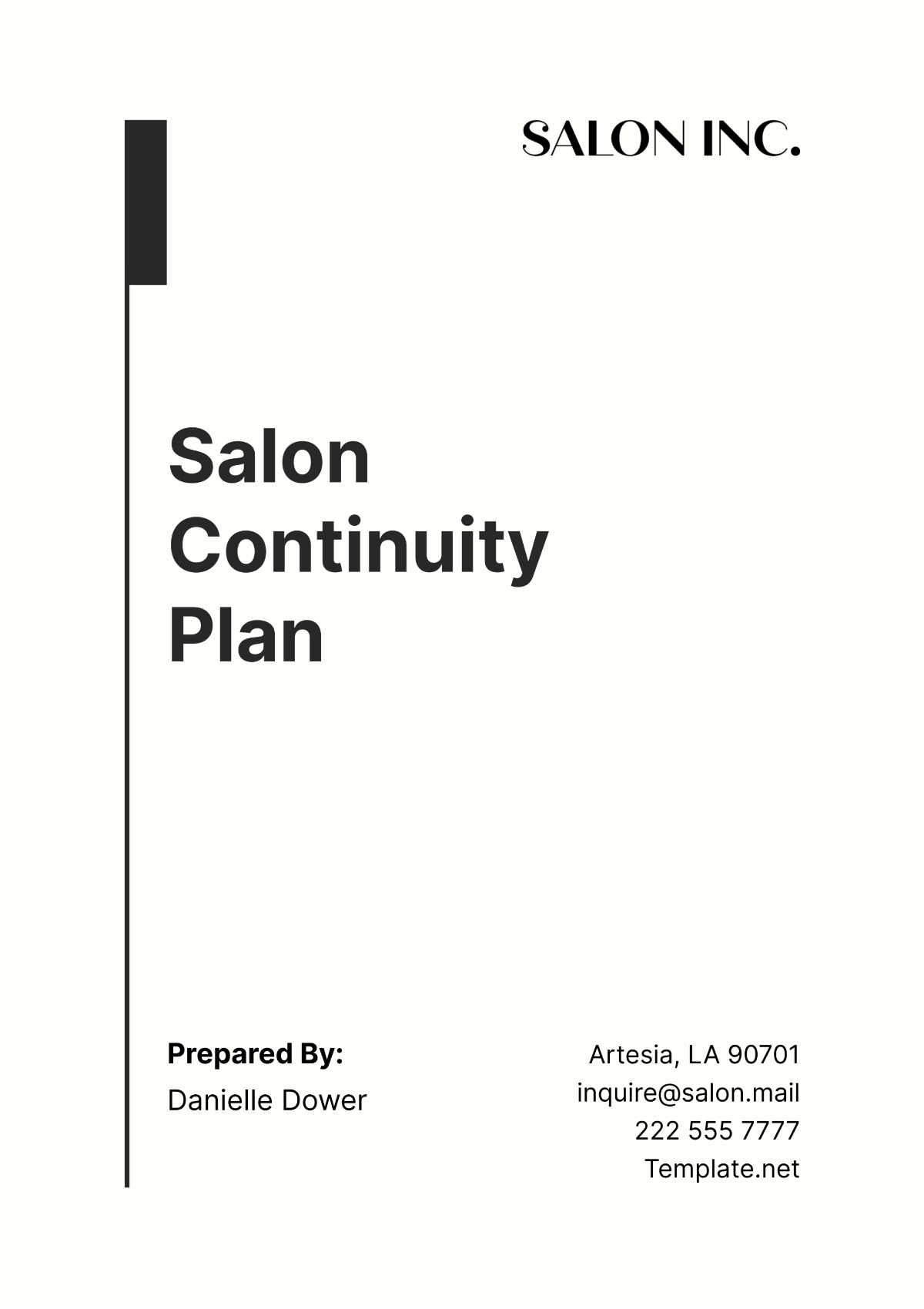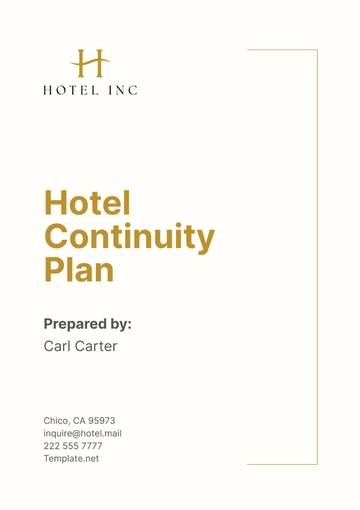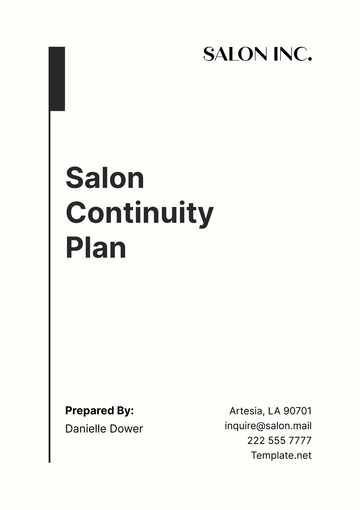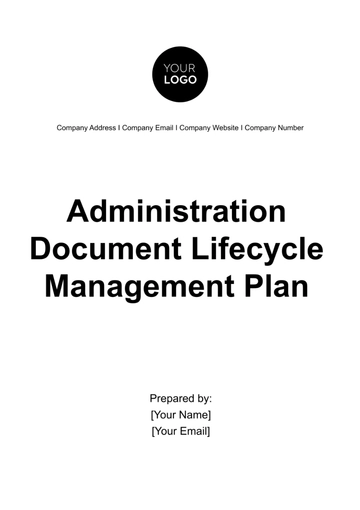Free Salon Continuity Plan

I. Executive Summary
The Salon Continuity Plan of [Your Company Name] details our advanced approach to ensuring seamless salon operations amidst unforeseen disruptions, such as economic shifts or health emergencies. Our strategy focuses on safeguarding the financial health of the business while preserving the well-being and trust of our clientele. Through implementing resilient business models and adopting state-of-the-art health standards, we remain dedicated to providing exceptional service without compromise.
In this document, we highlight the innovative measures [Your Company Name] will employ to adapt to changing market dynamics and client needs. These include the integration of virtual consultation services, enhanced sanitation protocols, and flexible appointment scheduling. Our plan not only addresses immediate safety concerns but also ensures long-term operational sustainability and customer satisfaction.
Our commitment extends beyond maintaining standard operations; it involves strategic financial planning and effective communication channels to keep our clients informed and engaged. By leveraging technology and continuous staff training, [Your Company Name] is poised to navigate through challenges with minimal disruption, ensuring a safe and welcoming environment for all clients.
II. Objective Overview
In this section, we outline the primary objectives of [Your Company Name]'s Salon Continuity Plan, designed to ensure operational resilience and financial stability under varying external pressures. By focusing on adaptability, client engagement, and robust risk management, we aim to not only sustain but also enhance our service quality and reputation during challenging times.
Objective | Strategy | Expected Outcome |
|---|---|---|
Sustain Operations | Implement flexible service models such as hybrid in-person and virtual appointments; adjust business hours as needed. | Continuous service delivery despite external disruptions. |
Safeguard Financial Strength | Optimize resource allocation; pursue diverse revenue streams through additional services like product sales and online tutorials. | Enhanced financial robustness and reduced dependency on single revenue sources. |
Preserve Reputation | Maintain high standards of customer service and safety; proactive communication with clients regarding changes and safety measures. | Strengthened client trust and loyalty, reinforcing brand integrity. |
Enhance Client Engagement | Utilize digital platforms for client interaction; offer personalized promotions and updates. | Increased customer satisfaction and retention. |
Robust Risk Management | Regularly update risk assessments; develop contingency plans for different types of disruptions. | Preparedness and quick response capability, minimizing potential impacts. |
This strategic framework ensures that [Your Company Name] not only anticipates challenges but also positions itself to thrive in an ever-evolving business landscape.
III. Identification of Key Business Areas
This section focuses on identifying critical business functions and areas crucial for the resilience of [Your Company Name]. Recognizing these pillars allows us to develop targeted strategies to enhance our capacity to withstand and adapt to disruptions. Our key areas of focus include Service Delivery, Customer Relations, Supply Chain Management, IT Systems, and Human Resources.
Key Business Area | Description | Importance to Continuity |
|---|---|---|
Service Delivery | Execution of salon services including hairstyling, treatments, and other beauty services. | Direct impact on revenue and client satisfaction. Critical for maintaining operational functionality. |
Customer Relations | Managing interactions with clients from appointment booking to service feedback. | Essential for client retention and reputation management. Strong relations drive repeat business. |
Supply Chain Management | Coordination of suppliers and inventory for salon essentials like beauty products and tools. | Ensures availability of necessary supplies to prevent service disruptions. |
IT Systems | Maintenance of digital infrastructure, including booking systems and client databases. | Supports business operations and data security, facilitating efficient client management and communication. |
Human Resources | Staff recruitment, training, and welfare. | Vital for sustaining quality service delivery and adapting to change through skilled and motivated staff. |
Understanding these key areas allows [Your Company Name] to create robust plans ensuring each segment operates efficiently and synergistically, contributing to the overall resilience and success of the business.
IV. Risk Assessment
Our comprehensive risk assessment is designed to pinpoint vulnerabilities across both internal and external domains that may impact [Your Company Name]'s operations. By categorizing and analyzing risks such as economic downturns, supply chain disruptions, and health pandemics, we prepare to mitigate these threats effectively.
Risk Category | Potential Risk | Impact Level | Preventative Measures |
|---|---|---|---|
Economic | Recession | High | Diversification of revenue streams to include services such as virtual consultations and exclusive member benefits. |
Operational | Supply Chain Disruption | Medium | Engagement with multiple suppliers and maintaining a strategic stock of critical supplies. |
Technological | System Failure | High | Implementation of regular system upgrades, backups, and robust cybersecurity measures. |
Health | Pandemic Outbreak | High | Comprehensive health and safety protocols, including enhanced sanitation practices, and adaptable service options (e.g., contactless services). |
Reputational | Poor Service Delivery | Medium | Implementation of stringent quality control measures and a dynamic client feedback system to promptly address and rectify service issues. |
This structured approach ensures that [Your Company Name] not only identifies potential threats but also implements strategic actions to prevent them, securing our operations and reinforcing our commitment to excellence.
V. Business Model Adaptation
To ensure [Your Company Name] remains at the forefront of the salon industry, especially under fluctuating market conditions, we are committed to developing a highly flexible business model. This proactive approach involves integrating adaptive strategies that cater to evolving customer needs and potential disruptions.
Adaptation | Description | Benefit |
|---|---|---|
Virtual Consultations | Offering real-time online consultations for clients who prefer remote interactions. | Enhances accessibility and convenience, expands client base beyond geographic limitations. |
Expanded Home Service Options | Providing a selection of services that can be delivered directly to clients' homes. | Satisfies the demand for personalized and private beauty experiences, crucial during restrictive public health scenarios. |
E-commerce Integrations | Launching an online platform for the sale of beauty products used in our salon. | Opens additional revenue streams and maintains sales even when in-person visits are reduced. |
By implementing these adaptations, [Your Company Name] not only safeguards its operational continuity but also leverages new opportunities to thrive in a dynamically changing business landscape. This strategy positions us to quickly respond to market shifts and client preferences, ensuring sustained growth and client satisfaction.
VI. Communication Strategy
Effective communication is the cornerstone of maintaining trust and efficiency at [Your Company Name], particularly during periods of disruption. Our strategic communication plan ensures that all stakeholders, from staff to clients, are kept informed and engaged with clear, timely information.
Stakeholder | Communication Method | Purpose | Details |
|---|---|---|---|
Clients | Social Media Updates | To provide real-time updates on changes to services, safety protocols, and operational hours. | Regular posts on platforms like Instagram and Facebook, including live Q&A sessions to directly address client concerns. |
Staff | Internal Briefings | To ensure all team members are aligned and informed about safety measures, operational changes, and client communication protocols. | Weekly meetings held via video conferencing or in-person while observing safety guidelines, supplemented by email updates. |
Clients and Staff | Dedicated Contingency Communication Channel | To maintain a reliable line of communication during unexpected disruptions. | Setup of a specific communication platform (e.g., Slack, Microsoft Teams) exclusively for urgent updates and directives. |
This comprehensive communication strategy not only reinforces our commitment to transparency but also strengthens the cohesion within our team and trust with our clients, ensuring [Your Company Name] navigates through challenges with unified efforts and clarity.
VII. Financial Stability Actions
Ensuring the ongoing financial health of [Your Company Name] is critical for maintaining resilience in the face of market fluctuations and other disruptions. Our strategy includes several key measures designed to fortify our financial foundation and secure long-term stability.
Measure | Description | Purpose |
|---|---|---|
Creation of a Financial Reserve | Establishing a dedicated savings account to act as a buffer against unforeseen expenses or revenue dips. | Provides financial security to sustain operations during unexpected economic downturns or other financial strains. |
Diversifying Income Streams | Expanding services to include alternative offerings such as online beauty tutorials, product sales, and specialized treatments. | Reduces dependency on traditional revenue sources and taps into new markets, enhancing overall revenue generation. |
Strict Budget Management Practices | Implementing rigorous budget controls and regular financial reviews to optimize spending and increase savings. | Ensures efficient use of resources, minimizes wasteful expenditure, and maximizes profitability. |
By adopting these financial stability actions, [Your Company Name] not only safeguards its economic position but also builds a robust platform for sustained growth and adaptability. This strategic financial planning is essential for supporting all other aspects of our continuity strategy.
VIII. Human Resources Management
At [Your Company Name], we recognize that our workforce is our most valuable asset, particularly during challenging times. Our human resources management strategy is designed to ensure that our team remains skilled, informed, and motivated, capable of delivering exceptional service regardless of external conditions.
Initiative | Description | Purpose |
|---|---|---|
Continuous Training | Providing ongoing professional development opportunities to enhance skills and adapt to new industry standards. | Ensures staff proficiency and adaptability, keeping our services at the cutting edge and enhancing job satisfaction. |
Flexible Working Arrangements | Implementing options such as remote work, flexible hours, and staggered shifts to accommodate personal needs and health guidelines. | Promotes work-life balance and safety, reducing stress and increasing productivity during disruptions. |
Psychological Support | Offering access to counseling services and support groups to help staff cope with the mental stresses of crisis situations. | Maintains mental health and job performance, crucial for sustaining operational effectiveness and employee well-being. |
Clear Communication of Job Roles | Re-defining and communicating job responsibilities clearly in the context of altered operations or business models. | Ensures all team members understand their roles and contributions within the evolving business framework, promoting efficiency and clarity. |
This comprehensive approach to human resources management ensures that [Your Company Name] not only supports its employees in times of crisis but also empowers them to contribute effectively to our ongoing success and resilience.
IX. Disaster Recovery Planning
[Your Company Name] is committed to robust disaster recovery planning to ensure swift and efficient recovery from significant disruptions. This comprehensive approach is designed to minimize downtime and safeguard our operations, clients, and data integrity.
Component | Description | Purpose |
|---|---|---|
Business Recovery Steps | Detailed procedures to restore business operations immediately after a disaster. Includes staff re-allocation and resource prioritization. | Enables rapid resumption of services, reducing financial and operational impacts of the disruption. |
Data Restoration and Backup Procedures | Regularly updated and tested backups of all critical data, both on-site and with cloud-based services. | Ensures that vital business information is preserved and can be quickly restored to maintain continuity. |
Temporary Relocation Strategies | Plans for temporary relocation of operations to alternative premises if the primary location becomes unusable. | Provides continuity of service by establishing a predefined alternative operational base, minimizing client and service disruption. |
This disaster recovery planning is essential for maintaining the resilience and stability of [Your Company Name], ensuring that we can respond effectively to any crisis and continue to provide high-quality service to our clients.
X. Continuous Improvement and Monitoring
At [Your Company Name], we understand that the landscape in which we operate is continuously evolving. Therefore, our continuity plan is dynamic, subject to regular evaluation and refinement to ensure it remains effective and aligned with both external conditions and internal needs.
Aspect | Description | Purpose |
|---|---|---|
Client Feedback | Systematic collection and analysis of feedback from clients regarding their service experience and safety perceptions. | Provides insights into client satisfaction and areas for service enhancement, ensuring alignment with client expectations. |
Financial Results | Review of financial performance metrics following the implementation of changes in the continuity plan. | Assesses the economic impact of adaptations, helping to refine financial strategies to optimize profitability. |
Staff Feedback | Regular solicitation of staff opinions on the new operational procedures and their efficacy. | Engages employees in the continuous improvement process, ensuring procedures are practical and enhance work efficiency. |
This continuous improvement and monitoring framework ensures that [Your Company Name] not only reacts to immediate challenges but also proactively shapes a resilient and client-focused business environment. By integrating feedback and performance data into our strategy, we maintain a plan that is robust, responsive, and reflective of our commitment to excellence.
XI. Implementation Roadmap
To effectively implement the Salon Continuity Plan at [Your Company Name], we have established a clear and structured timeline with specific milestones. This roadmap ensures that every aspect of the plan is executed methodically and on schedule, supporting our goals of resilience and sustainability.
Milestone | Time Frame | Details |
|---|---|---|
Immediate Staff Training | Immediate | Conduct comprehensive training sessions on emergency procedures and communication protocols. |
Launch of Virtual Consultation Services | Within 2 months | Develop and introduce virtual consultation capabilities to offer remote service options to clients. |
Establishment of Financial Reserves and Diversification | Within 6 months | Set up financial reserves and implement strategies for income diversification to enhance financial stability. |
Integration of E-commerce Solutions | Within 1 year | Fully integrate online platforms for the sale of beauty products, expanding our market reach. |
Continuous Monitoring and Annual Reviews | Ongoing/Annually | Regularly monitor the effectiveness of the continuity plan and conduct annual reviews for necessary adjustments. |
This roadmap is designed to facilitate a systematic and phased implementation of critical initiatives, ensuring [Your Company Name] not only adapts to immediate challenges but also thrives in a changing business landscape.
- 100% Customizable, free editor
- Access 1 Million+ Templates, photo’s & graphics
- Download or share as a template
- Click and replace photos, graphics, text, backgrounds
- Resize, crop, AI write & more
- Access advanced editor
Ensure your salon’s resilience with Template.net’s Salon Continuity Plan Template. This editable and customizable document is tailored specifically for the unique challenges of the beauty industry. Enhance your preparedness strategy easily, editable in our Ai Editor Tool. Invest in your business’s future by drafting a robust continuity plan today, ensuring you remain operational and prosperous regardless of unforeseen circumstances. Get started now!
You may also like
- Finance Plan
- Construction Plan
- Sales Plan
- Development Plan
- Career Plan
- Budget Plan
- HR Plan
- Education Plan
- Transition Plan
- Work Plan
- Training Plan
- Communication Plan
- Operation Plan
- Health And Safety Plan
- Strategy Plan
- Professional Development Plan
- Advertising Plan
- Risk Management Plan
- Restaurant Plan
- School Plan
- Nursing Home Patient Care Plan
- Nursing Care Plan
- Plan Event
- Startup Plan
- Social Media Plan
- Staffing Plan
- Annual Plan
- Content Plan
- Payment Plan
- Implementation Plan
- Hotel Plan
- Workout Plan
- Accounting Plan
- Campaign Plan
- Essay Plan
- 30 60 90 Day Plan
- Research Plan
- Recruitment Plan
- 90 Day Plan
- Quarterly Plan
- Emergency Plan
- 5 Year Plan
- Gym Plan
- Personal Plan
- IT and Software Plan
- Treatment Plan
- Real Estate Plan
- Law Firm Plan
- Healthcare Plan
- Improvement Plan
- Media Plan
- 5 Year Business Plan
- Learning Plan
- Marketing Campaign Plan
- Travel Agency Plan
- Cleaning Services Plan
- Interior Design Plan
- Performance Plan
- PR Plan
- Birth Plan
- Life Plan
- SEO Plan
- Disaster Recovery Plan
- Continuity Plan
- Launch Plan
- Legal Plan
- Behavior Plan
- Performance Improvement Plan
- Salon Plan
- Security Plan
- Security Management Plan
- Employee Development Plan
- Quality Plan
- Service Improvement Plan
- Growth Plan
- Incident Response Plan
- Basketball Plan
- Emergency Action Plan
- Product Launch Plan
- Spa Plan
- Employee Training Plan
- Data Analysis Plan
- Employee Action Plan
- Territory Plan
- Audit Plan
- Classroom Plan
- Activity Plan
- Parenting Plan
- Care Plan
- Project Execution Plan
- Exercise Plan
- Internship Plan
- Software Development Plan
- Continuous Improvement Plan
- Leave Plan
- 90 Day Sales Plan
- Advertising Agency Plan
- Employee Transition Plan
- Smart Action Plan
- Workplace Safety Plan
- Behavior Change Plan
- Contingency Plan
- Continuity of Operations Plan
- Health Plan
- Quality Control Plan
- Self Plan
- Sports Development Plan
- Change Management Plan
- Ecommerce Plan
- Personal Financial Plan
- Process Improvement Plan
- 30-60-90 Day Sales Plan
- Crisis Management Plan
- Engagement Plan
- Execution Plan
- Pandemic Plan
- Quality Assurance Plan
- Service Continuity Plan
- Agile Project Plan
- Fundraising Plan
- Job Transition Plan
- Asset Maintenance Plan
- Maintenance Plan
- Software Test Plan
- Staff Training and Development Plan
- 3 Year Plan
- Brand Activation Plan
- Release Plan
- Resource Plan
- Risk Mitigation Plan
- Teacher Plan
- 30 60 90 Day Plan for New Manager
- Food Safety Plan
- Food Truck Plan
- Hiring Plan
- Quality Management Plan
- Wellness Plan
- Behavior Intervention Plan
- Bonus Plan
- Investment Plan
- Maternity Leave Plan
- Pandemic Response Plan
- Succession Planning
- Coaching Plan
- Configuration Management Plan
- Remote Work Plan
- Self Care Plan
- Teaching Plan
- 100-Day Plan
- HACCP Plan
- Student Plan
- Sustainability Plan
- 30 60 90 Day Plan for Interview
- Access Plan
- Site Specific Safety Plan




